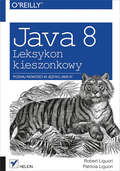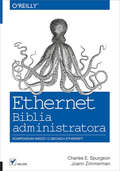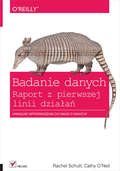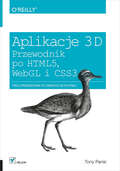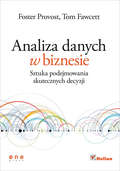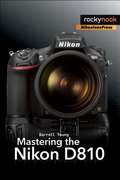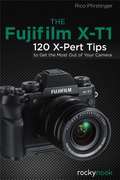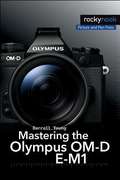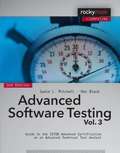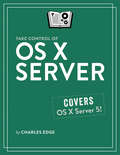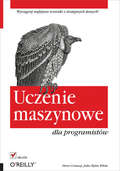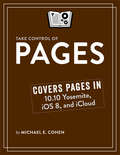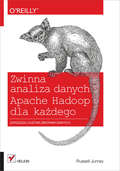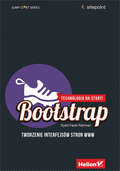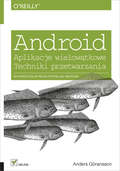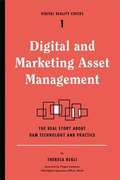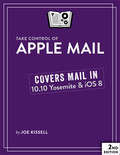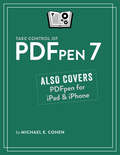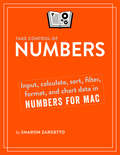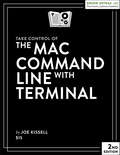- Table View
- List View
Java 8. Leksykon kieszonkowy
by Patricia Liguori Robert Liguori??Java jest dzi? j?zykiem, który programi?ci wybieraj? najcz??ciej, gdy maj? przed sob? skomplikowany projekt, wymagaj?cy najwy?szej wydajno?ci, jako?ci, bezpiecze?stwa oraz integracji z innymi systemami. Rozwijany od blisko dwudziestolecia, j?zyk ten doczeka? si? wersji oznaczonej numerem 8. Ta edycja zosta?a wzbogacona o wiele nowo?ci, m.in. o d?ugo oczekiwane wyra?enia lambda. Je?eli szukasz por?cznej ksi??ki, do której mo?esz si?gn?? w przypadku w?tpliwo?ci, to trafi?e? na doskona?? pozycj?!Ta publikacja nale?y do popularnej serii „Leksykon kieszonkowy” i mo?esz mie? j? zawsze przy sobie. W ?rodku znajdziesz konwencje nazw oraz podstawowe elementy j?zyka. W kolejnych rozdzia?ach zdob?dziesz wiedz? na temat typów prostych oraz programowania zorientowanego obiektowo. Ponadto zawarto tu przyst?pne omówienie wyra?e? lambda, wspó?bie?no?ci oraz zasad dost?pu do plików i sieci. Java posiada rozbudowany mechanizm obs?ugi sytuacji wyj?tkowych, który równie? zosta? omówiony w tym podr?czniku. Ksi??ka ta jest obowi?zkow? pozycj? na pó?ce ka?dego programisty j?zyka Javy — je?li chce on mie? zawsze pod r?k? wiarygodne ?ród?o informacji na temat tego j?zyka.Dzi?ki tej ksi??ce:- poznasz elementy i sk?adni? j?zyka Java- zrozumiesz zasad? dzia?ania wyra?e? lambda- wykorzystasz nowe metody dost?pu do plików- zaznajomisz si? z nowo?ciami w Javie 8- b?dziesz mie? zawsze pod r?k? solidne ?ród?o wiedzyTwój przewodnik po j?zyku Java!
Ethernet. Biblia administratora
by Joann Zimmerman Charles E. SpurgeonKompendium wiedzy o sieciach Ethernet! Biblia administratora sieci Ethernet!Standard Ethernet powsta? w 1976 roku w o?rodku badawczym firmy Xerox. Wykorzystywany do budowy sieci lokalnych, znajduje zastosowanie praktycznie w ka?dym miejscu. Sieci Ethernet spotkasz zarówno w mieszkaniach czy domach, jak i w biurach czy centrach danych. W zale?no?ci od bud?etu, jakim dysponujesz, mo?esz zbudowa? sie? dostosowan? do w?asnych potrzeb. Nowoczesne sieci Ethernet pozwalaj? na niezawodne przesy?anie danych z ogromnymi pr?dko?ciami.W Twoje r?ce oddajemy bibli? wiedzy o sieciach Ethernet, która odpowie na wszystkie nurtuj?ce Ci? pytania oraz zaprezentuje nowoczesne techniki wykorzystania tych sieci. Przekonasz si?, jak wygl?da proces automatycznej negocjacji oraz jak zasila? urz?dzenia za pomoc? Ethernetu. W kolejnych rozdzia?ach znajdziesz charakterystyczne elementy popularnych sieci 10, 100 i 1000 Mb/s oraz niezwykle wydajnych sieci o pr?dko?ci dochodz?cej do 400 Gb/s. Trzecia cz??? tej ksi??ki zosta?a po?wi?cona budowie systemu Ethernet. Poznasz tu systemy okablowania strukturalnego, dost?pne kable, z??cza oraz prze??czniki. Ksi??ka ta jest obowi?zkow? pozycj? na pó?ce ka?dego administratora, który chce pozna? swoj? sie? od podszewki.Dzi?ki tej ksi??ce: poznasz histori? standardu Ethernet zrozumiesz zasad? jego dzia?ania zobaczysz, jaki potencja? kryj? sieci Ethernet nauczysz si? projektowa? wydajne rozwi?zania poznasz tajniki dzia?ania Twojej sieciCharles Spurgeon jest starszy architektem technologii na Uniwersytecie Stanu Texas w Austin, gdzie pracuje z systemem sieci kampusu obs?uguj?cej ponad 70 000 u?ytkowników w 200 budynkach. Pomaga? budowa? prototyp routerów ethernetowych, które sta?y si? podstaw? dla technologii urz?dze? produkowanych przez Cisco Systems.Joann Zimmerman jest in?ynierem oprogramowania. Jest twórczyni? i autork? dokumentacji kompilatorów, narz?dzi wytwarzania oprogramowania i oprogramowania do monitorowania sieci. Bra?a równie? udzia? w tworzeniu procesu zarz?dzania konfiguracj? i kompilacj? w kilku firmach.
Badanie danych. Raport z pierwszej linii dzia?a?
by Cathy O'Neil Rachel SchuttUnikalne wprowadzenie do nauki o danych!W dzisiejszych czasach najcenniejszym dobrem jest informacja. Ogromne ilo?ci danych s? przechowywane w przepastnych bazach danych, a kluczem do sukcesu jest ich umiej?tna analiza i wyci?ganie wniosków. To dynamicznie rozwijaj?ca si? dziedzina wiedzy, w której do tej pory brakowa?o solidnych podr?czników, pozwalaj?cych na dog??bne poznanie tego obszaru. Na szcz??cie to si? zmieni?o! Trzymasz w?a?nie w r?kach unikaln? ksi??k?, w której badacze z najwi?kszych firm bran?y IT dziel? si? skutecznymi technikami analizy danych. Z kolejnych rozdzia?ów dowiesz si?, czym jest nauka o danych, model danych oraz test A/B. Ponadto zdob?dziesz wiedz? na temat wnioskowania statystycznego, algorytmów, j?zyka R oraz wizualizacji danych. Si?gnij po t? ksi??k?, je?eli chcesz si? dowiedzie?, jak wykrywa? oszustwa, korzysta? z MapReduce oraz bada? przyczynowo??. To obowi?zkowa pozycja na pó?ce czytelników zainteresowanych badaniem danych.Dzi?ki tej ksi??ce: poznasz zaawansowane sposoby analizy danych nauczysz si? korzysta? z MapReduce zwizualizujesz posiadane dane i wykryjesz oszustwa poznasz podstawy j?zyka R wyci?gniesz warto?ciowe wnioski z posiadanych danychWyci?gnij warto?ciowe wnioski z posiadanych informacji!
Aplikacje 3D. Przewodnik po HTML5, WebGL i CSS3
by Tony ParisiTwój przewodnik po grafice 3D w HTML!Do niedawna wywietlanie zaawansowanej grafiki 3D w przegl?darce internetowej wymaga?o zainstalowania dodatkowych wtyczek oraz poznawania nowych narz?dzi. Dzi?ki HTML5 i WebGL te czasy powoli odchodz? w niepami??! Teraz mo?esz wykorzysta? niesamowite mo?liwoci tego duetu, by zaskoczy? u?ytkowników atrakcyjnymi efektami 3D!Ta wyj?tkowa ksi??ka zosta?a w ca?oci powi?cona w?anie zagadnieniom zwi?zanym z grafik? 3D w przegl?darce internetowej. Si?gnij po ni? i przekonaj si?, jak wykorzysta? API WebGL do renderowania trójwymiarowej grafiki w czasie rzeczywistym. W kolejnych rozdzia?ach poznasz bibliotek? j?zyka JavaScript Three.js, która w znacz?cy sposób u?atwia ?ycie programisty. Informacje zawarte w dalszych rozdzia?ach pozwol? Ci skorzysta? z zaawansowanych efektów w CSS3 i tworzy? animacje trójwymiarowe. Zaznajomisz si? te? z detalami tworzenia aplikacji dla urz?dze? mobilnych. Twoj? uwag? z pewnoci? przykuje przegl?d narz?dzi do tworzenia trójwymiarowych modeli i animacji zarówno tych klasycznych, jak i tych online. Ksi??ka ta jest doskona?? lektur? dla wszystkich deweloperów chc?cych wzbogaci? swój warsztat o elementy grafiki 3D.Dzi?ki tej ksi??ce: zapoznasz si? z podstawami teorii dla grafiki 3D poznasz API WebGL wykorzystasz bibliotek? Three.js w codziennej pracy odkryjesz narz?dzia przydatne w codziennej pracy jeszcze bardziej uatrakcyjnisz Twoj? stron? Poznaj potencja? HTML5 w zakresie grafiki 3D! "Tony Parisi od samego pocz?tku wiedzie prym w dziedzinie rewolucyjnych rozwi?za? pozwalaj?cych zago?ci? interaktywnym aplikacjom trójwymiarowym w internecie. Jego nowa ksi??ka zawiera dog??bne informacje na temat tych technologii oraz tworzenia najnowocze?niejszych trójwymiarowych aplikacji naprawd? dzia?aj?cych w aktualnie dost?pnych przegl?darkach".- Neil Trevettwiceprezes ds. tre?ci mobilnej w firmie NVIDIA i prezes organizacji Khronos Group
Analiza danych w biznesie. Sztuka podejmowania skutecznych decyzji
by Tom Fawcett Foster ProvostWszystko co powiniene? wiedzie? o eksploracji danych i my?leniu w kategoriach analityki danych. Wyci?gaj trafne wnioski! „Lektura obowi?zkowa dla ka?dego, kto powa?nie my?li o wykorzystaniu okazji, jakie nios? ze sob? wielkie zbiory danych”.— Craig Vaughan, globalny wiceprezes SAPPosiadanie zbiorów danych to po?owa sukcesu. Druga po?owa to umiej?tno?? ich skutecznej analizy i wyci?gania wniosków. Dopiero na tej podstawie b?dziesz w stanie w?a?ciwie oceni? kondycj? Twojej firmy oraz podj?? s?uszne decyzje. Wiedza zawarta w tej ksi??ce mo?e zadecydowa? o sukcesie biznesowym lub pora?ce. Nie ryzykuj i si?gnij po to doskona?e ?ród?o wiedzy, po?wi?cone nauce o danych.To unikalny podr?cznik, który pomo?e Ci sprawnie opanowa? nawet najtrudniejsze zagadnienia zwi?zane z analiz? danych. Dowiedz si?, jak zbudowany jest proces eksploracji danych, z jakich narz?dzi mo?esz skorzysta? oraz jak stworzy? model predykcyjny i dopasowa? go do danych. W kolejnych rozdzia?ach przeczytasz o tym, czym grozi nadmierne dopasowanie modelu i jak go unika? oraz jak wyci?ga? wnioski metod? najbli?szych s?siadów. Na koniec zaznajomisz si? z mo?liwo?ciami wizualizacji skuteczno?ci modelu oraz odkryjesz zwi?zek pomi?dzy nauk? o danych a strategi? biznesow?. To obowi?zkowa lektura dla wszystkich osób chc?cych podejmowa? ?wiadome decyzje na podstawie posiadanych danych!Dzi?ki tej ksi??ce: poznasz model predykcyjny dowiesz si?, jak dopasowa? model do danych zwizualizujesz skuteczno?? zbudowanego modelu zwi?kszysz swoje szanse na osi?gni?cie sukcesu biznesowegoPrzeanalizuj posiadane dane i podejmij trafne decyzje! Ta ksi??ka wykracza poza sfer? podstaw analityki danych. To niezb?dny przewodnik dla tych z nas (nas wszystkich?), których firmy zosta?y zbudowane w oparciu o wszechobecno?? okazji biznesowych, wi???cych si? z danymi, i nowe mo?liwo?ci podejmowania decyzji w oparciu o dane.— Tom Phillips, prezes Distillery i by?y szef Google Search i Google Analytics
Creative Flash Photography
by Tilo GockelMake a big impression with small flashes! In this book, Tilo Gockel shows you how to make magic by mastering the use of light. You will learn how to use speedlights to create amazing photographs in any lighting situation. Tilo uses 40 lighting workshops to teach his methods for producing impressive flash shots in portrait, fashion, macro, food, still life, and high-speed photography.The richly illustrated, easy-to-understand workshops are filled with recommendations and instructions for flash setups, detailed lighting diagrams, and tips and tricks for how to achieve the look of high-end studio shots using simple, accessible equipment, even in your own home. Also included is information on the settings that will help you master complex multi-flash situations, as well as tips on how to create cost-effective, self-built accessories.Foreword by Strobist.com's David Hobby.
Mastering the Nikon D800
by Darrell YoungMastering the Nikon D800 by Darrell Young provides a wealth of experience-based information and insights for owners of the new D800 camera. Darrell is determined to help the user navigate past the confusion that often comes with complex and powerful professional camera equipment. This book explores the features and capabilities of the camera in a way that far surpasses the user's manual. It guides readers through the camera features with step-by-step setting adjustments; color illustrations; and detailed how, when, and why explanations for each option. Every button, dial, switch, and menu configuration setting is explored in a user-friendly manner, with suggestions for setup according to various shooting styles. Darrell's friendly and informative writing style allows readers to easily follow directions, while feeling as if a friend dropped in to share his knowledge. The learning experience for new D800 users goes beyond just the camera itself and covers basic photography technique.
The Fujifilm X-E2
by Rico PfirstingerThe Fujifilm X-E2: Beyond the Manual provides experience-based information and insights for owners of the Fujifilm X-E2 mirrorless system camera. Fuji X-Pert series author Rico Pfirstinger teaches little-known capabilities of the X-E2 that he's discovered through several months of in-depth research. This book focuses on insights that you won't find in the manual, skipping tedious explanations of basic camera functions and operations. Instead, it cuts to the chase and provides readers with a plethora of tips and practical instructions that will enable them to fully explore the capabilities of the X-E2.The X-E2 combines classic design with state-of-the-art digital camera technology originally seen in the X-Pro1 and X-E1 system cameras. These features have been further improved to achieve the X-E2: Fujifilm's most capable camera to-date, with an ever-growing set of already more than ten interchangeable X-Mount lenses. The Fujifilm X-E2: Beyond the Manual presents numerous tips and tricks that will maximize your ability to use the Fujifilm X-E2 to its full potential.
Mastering the Olympus OM-D E-M1
by Darrell YoungOlympus launched the OM-D E-M1 camera with a specific purpose in mind: to create a Micro Four Thirds camera for professional and advanced enthusiast photographers. As the flagship Micro Four Thirds camera, the E-M1 is the peak of the Olympus digital imaging system. It is a true system camera for those who demand the best in cameras, lenses, and image quality.Darrell Young's Mastering the Olympus OM-D E-M1 explores the features and capabilities of the camera in a way that far surpasses the user's manual. It is designed to guide readers through the camera's features with step-by-step setting adjustments; color illustrations; and detailed how, when, and why explanations for each option. Every button, dial, switch, and menu configuration setting is explored in a user-friendly manner, with suggestions for setup according to various shooting styles.Darrell's friendly and informative writing style allows readers to easily follow directions while feeling as if a friend dropped in to share his knowledge. The learning experience for new E-M1 users goes beyond just the camera itself and covers basic photography technique.This book is based on firmware 3.0.
Advanced Software Testing - Vol. 3, 2nd Edition
by Rex Black Jamie L MitchellThis book is written for the technical test analyst who wants to achieve advanced skills in test analysis, design, and execution. With a hands-on, exercise-rich approach, this book teaches you how to define and carry out the tasks required to implement a test strategy. You will be able to analyze, design, implement, and execute tests using risk considerations to determine the appropriate effort and priority for tests. This book will help you prepare for the ISTQB Advanced Technical Test Analyst exam. Included are sample exam questions for most of the learning objectives covered by the latest (2012) ISTQB Advanced Level syllabus. The ISTQB certification program is the leading software tester certification program in the world. You can be confident in the value and international stature that the Advanced Technical Test Analyst certificate will offer you.With over thirty years of software and systems engineering experience, author Rex Black is President of RBCS, a leader in software, hardware, and systems testing, and the most prolific author practicing in the field of software testing today. Previously, he served as President of both the International and American Software Testing Qualifications Boards (ISTQB and ASTQB).Jamie Mitchell is a consultant who has been working in software testing, test automation, and development for over 20 years. He was a member of the Technical Advisory Group for ASTQB, and one of the primary authors for the ISTQB Advanced Technical Test Analyst 2012 syllabus.
Take Control of OS X Server
by Charles EdgeLearn to run your own server for file, calendar, backup, and other services!We won't beat around the bush -- running Apple's OS X Server requires a lot more knowledge and effort than most other activities on the Mac. No matter how easy Apple makes working within the Server app, there are terms, concepts, and procedures you should understand before tackling server installation and management. Unless you know what to enter and why, your server won't work, or worse, its important data might be vulnerable to outside attack or hardware failure.For anyone in a home or small office situation who needs help with OS X Server, Charles Edge draws on years of experience as the CTO of a national consultancy and managed services provider to give you the essential background explanations, step-by-step instructions, and real-world advice you need to set up and run OS X Server successfully. You'll learn how to set up file sharing, create shared calendars, run your own Web server and wiki, coordinate Mac and iOS software updates for your users, manage your organization's iOS devices (MDM), and provide networked Time Machine backups, among much else. A final chapter offers advice on how to keep your server running smoothly.What about Yosemite? This book was written with OS X 10.9 Mavericks and OS X Server 3.2.2, and nearly all the instructions also work with 10.10 Yosemite and OS X Server 4.0.In the book, you'll find answers to many OS X Server-related questions, including:What's the best Mac to use as a server?How much RAM and drive space should my server have?What's the best way to speed up a server whose performance is lagging?Why is it important to set up directory services early on?Which ports need to be opened to make services available to the Internet?What's the big deal about running a mail server?Is there a good way to share contacts between people? (No, sorry.)Can OS X Server provide a private messaging service?Will I be able to enforce iPad device restrictions via Profile Manager?Does setting up an organization wiki requires the Websites service?Should I use the Software Update or Caching service, or both?What should I do if Time Machine on a client Mac can't connect to the server?Note: This book assumes that the average reader has one router, one network, and one server (although there are a few spots where it discusses how multiple servers interact). Large installations will have different configurations by necessity. Similarly, the book does not cover imaging, Xsan, or VPNs.
Uczenie maszynowe dla programistów
by John Myles White Drew ConwayWyci?gnij najlepsze wnioski z dost?pnych danych!Maszyna my?l?ca jak cz?owiek to marzenie ludzko?ci. Dzi?ki dzisiejszej wiedzy i dost?pnym narz?dziom wci?? przybli?amy si? do jego spe?nienia. Zastanawiasz si?, jak nauczy? maszyn? my?lenia? Jak sprawi?, ?eby podejmowa?a trafne decyzje oraz przewidywa?a najbli?sz? przysz?o?? na podstawie przygotowanych modeli? Na to i wiele innych pyta? odpowiada ta wspania?a ksi??ka.Dzi?ki niej poznasz j?zyk R, nauczysz si? eksplorowa? dost?pne dane, okre?la? warto?? mediany i odchylenia standardowego oraz wizualizowa? powi?zania mi?dzy kolumnami. Gdy opanujesz ju? solidne podstawy teoretyczne, mo?esz ?mia?o przej?? do kolejnych rozdzia?ów i zapozna? si? z klasyfikacj? binarn?, tworzeniem rankingów oraz modelowaniem przysz?o?ci przy u?yciu regresji. Ponadto zrozumiesz, jak tworzy? systemy rekomendacyjne, analizowa? sieci spo?eczne oraz ?ama? szyfry. Ksi??ka ta jest doskona?? lektur? dla pasjonatów analizy danych i wyci?gania z nich wniosków.Ka?dy rozdzia? ksi??ki jest po?wi?cony konkretnemu zagadnieniu uczenia maszynowego: klasyfikacji, predykcji, regresji, optymalizacji i wreszcie rekomendacji. Czytelnik nauczy si? konstruowa? proste algorytmy uczenia maszynowego (i przepuszcza? przez nie próbki danych) za pomoc? j?zyka programowania R. Uczenie maszynowe dla programistów jest wi?c znakomit? lektur? dla programistów paraj?cych si? czy to projektami komercyjnymi, czy to rz?dowymi, czy wreszcie akademickimi. Skonstruuj prosty klasyfikator bayesowski odró?niaj?cy wiadomo?ci tre?ciwe od niechcianych na podstawie ich zawarto?ci. U?ywaj regresji liniowej do przewidywania liczby odwiedzin najpopularniejszych stron WWW. Naucz si? optymalizacji, próbuj?c z?ama? prosty szyfr literowy. Statystycznie skonfrontuj pogl?dy polityków, u?ywaj?c rejestru g?osowa?. Zbuduj system rekomendacji warto?ciowych twitterowców.Naucz si? czyta? i analizowa? dane!Ksi??ka ta stanowi ?wietny przegl?d przypadków i tuzina ró?nych technik uczenia maszynowego. Jest ukierunkowana na proces dochodzenia do rozwi?zania, a nie gotowe recepty ani abstrakcyjne teorie; dzi?ki temu jej materia? jest dost?pny dla wszystkich programistów, ale te? przys?owiowych „umys?ów ?cis?ych”— Max Shron, OkCupid
Take Control of Pages
by Michael E CohenWork effectively in Pages in OS X Yosemite, iOS 8, and iCloud!Apple's Pages word processor is a big, sprawling app with hundreds of features tucked away in nooks and crannies, making Michael E. Cohen's comprehensive book an essential resources for newbies and experts alike. Those new to Pages, or still getting their sea legs in the transition to Pages 5 will appreciate Michael's guide to finding familiar tools, formatting text, and iCloud Drive quirks. And everyone will benefit from the book's discussion of advanced features like snaking columns (snarky columns are left as an exercise to the reader), list styles, layout options, and collaboration tools.Whether you need quick help with a particular feature or steel-toed documentation with which to kick Pages into shape, this book is for you.Still running 10.9 Mavericks? Mavericks users can still find plenty of Pages help here. To find out what's different, read What about Mavericks?.The book offers plenty of help with word processing:For everyday word processing, you'll find directions for working with fonts, tabs, indents, rulers, search and replace, spell checking, and more.For longer, more complex documents, you'll learn how to control headers, footers, page numbers, footnotes, and section breaks. Plus you'll find oodles of help with character styles, paragraph styles, and even list styles.For projects that go way beyond the norm, you'll learn how to create your own templates, complete with master objects.For collaborative projects, you'll come up to speed with the track changes and commenting features. You can also use the newfangled Share icon to collaborate with others (simultaneously) in an iCloud-based Pages document.Layout and graphics merit attention too, in terms of:Turning off the usual word processing text flow so you can lay out independent objects more easily (perfect for posters!)Inserting text boxes, vector graphics, and all manner of mediaStyling text boxes and vector graphics with whizzy object styles (for example, you can specify a specific color and shadow)Being precise with smart guides and vertical rulersCreating a custom look with fills, shadows, opacity, and moreWorking in tables (which can act as mini spreadsheets) and creating chartsYou'll also find thoughtful directions for managing your documents:What happens with fonts and features when you move Pages documents between Mac, iOS, and iCloudWhether and how to work with Pages documents in iCloud DriveHow to import from Pages 4 (aka Pages '09), Word, text, and RTFHow to export to Pages 4, Word, text, EPUB, and PDFAnd lots more!
Zwinna analiza danych. Apache Hadoop dla ka?dego
by Russell JurneyDu?e zbiory danych dla ka?dego! W dobie Big Data klasyczne podej?cie do analizy danych nie przynosi ju? po??danych wyników. Skuteczna analiza gigantycznych zbiorów informacji, wyci?ganie interesuj?cych wniosków i prezentowanie ich w przejrzystej formie u?ytkownikowi wymagaj? mnóstwa czasu i ?rodków. Zastanawiasz si?, jak podej?? do tego problemu, by zminimalizowa? ryzyko niepowodzenia? Na to i wiele innych pyta? odpowiada ta fantastyczna ksi??ka.Dzi?ki niej dowiesz si?, jak zaprz?c platform? Hadoop do w?asnych celów. Skorzystasz z prostych narz?dzi, takich jak j?zyk Python, biblioteka D3.js oraz Apache Pig, i zastosujesz zwinne podej?cie do problemu, by osi?gn?? zaskakuj?ce efekty. Ponadto przekonasz si?, jak ?atwo mo?na publikowa? dane w MongoDB, stosowa? wyszukiwark? ElasticSearch oraz wykorzysta? potencja? chmur obliczeniowych. Nauczysz si? tak?e wizualizowa? dane na wykresach, prognozowa? oraz podejmowa? w?a?ciwe dzia?ania. Ksi??ka ta jest doskona?? lektur? dla wszystkich osób stoj?cych przed problemem skutecznej pracy z ogromnymi zbiorami danych.Dzi?ki tej ksi??ce: poznasz najlepsze narz?dzia do przetwarzania zbiorów danych wykorzystasz mo?liwo?ci j?zyka Python sprawdzisz mo?liwo?ci chmur obliczeniowych b?yskawicznie wyszukasz dane za pomoc? ElasticSearch zwizualizujesz dane z u?yciem D3.jsZwinnie rozwi?? problemy z du?ymi zbiorami danych!„Przy tak du?ej popularno?ci zagadnie? Big Data i Data Science, lektura praktycznego instrukta?u budowy aplikacji analitycznych jest mocno od?wie?aj?ca. Russel Jurney wprowadza nas, ma?ymi porcjami implementacji, w swoj? filozofi? zwinno?ci w dziedzinie analizy i aplikacyjnego wykorzystywania danych.”Mat Kelcey, matpalm.com
Bootstrap. Tworzenie interfejsów stron WWW. Technologia na start!
by Syed Fazle RahmanOpanuj Bootstrapa w weekend. Responsive Web Design dla ka?dego! Bootstrap to obecnie jeden z najpopularniejszych szkieletów do tworzenia atrakcyjnych interfejsów stron WWW. Projekt zapocz?tkowany przez programistów Twittera zyska? licznych zwolenników ze wzgl?du na bogactwo komponentów, ?wietn? dokumentacj? i zgodno?? z ró?nymi przegl?darkami internetowymi. Nie bez znaczenia jest równie? fakt, ?e Bootstrap wspiera budow? responsywnych stron WWW.Ta ksi??ka to rewelacyjny przewodnik, który wprowadzi Ci? w ?wiat Bootstrapa. Na samym pocz?tku poznasz system siatkowy (ang. grid), który jest fundamentem tworzenia responsywnych uk?adów. Na kolejnych stronach znajdziesz omówienie poszczególnych komponentów tego szkieletu. Po opanowaniu podstaw przejdziesz do sposobów rozszerzania Bootstrapa, modyfikowania go oraz optymalizowania. Ksi??ka ta jest doskona?? lektur? dla wszystkich osób chc?cych b?yskawicznie pozna? i wykorzysta? ten szkielet! Przeczytaj o instalacji Bootstrapa i konfigurowaniu projektów. Dowiedz si?, w jaki sposób Bootstrap mo?e przyspieszy? proces projektowania. Opanuj tajniki systemu siatkowego: twórz responsywne, zoptymalizowane pod k?tem urz?dze? mobilnych szablony stron, które b?d? dzia?a?y na ka?dym urz?dzeniu. Wykorzystaj zalety komponentów Bootstrapa do b?yskawicznego i wygodnego rozbudowania strony o funkcje takie jak panele, paski nawigacji czy formularze. U?yj rozszerze? do tworzenia interaktywnych elementów strony, bez konieczno?ci pisania cho?by jednej linii kodu JavaScript! Zmodyfikuj Bootstrapa, by móc tworzy? wyj?tkowe, oryginalne strony.Wszystko co musisz wiedzie? o Bootstrapie, zebrane w jednym miejscu!
Android. Aplikacje wielow?tkowe. Techniki przetwarzania
by Anders GoranssonWykorzystaj w pe?ni potencja? w?tków! Je?eli chcesz tworzy? aplikacje dostarczaj?ce u?ytkownikom doskona?ych wra?e?, je?eli chcesz wykonywa? skomplikowane zadania szybciej lub po prostu musisz jednocze?nie wykonywa? ró?ne dzia?ania — naucz si? korzysta? z w?tków. Tworzenie programów wielow?tkowych jest trudne, ale opanowanie tej sztuki pozwoli Ci osi?gn?? wymierne korzy?ci!Ta ksi??ka w ca?o?ci po?wi?cona jest korzystaniu z w?tków na platformie Android. Dzi?ki niej poznasz przeró?ne sposoby asynchronicznego przetwarzania oraz ich zalety i wady. Jednak na samym pocz?tku zapoznasz si? z podstawowymi informacjami dotycz?cymi wielow?tkowo?ci w j?zyku Java. Dowiesz si?, w jaki sposób w?tki komunikuj? si? ze sob? i synchronizuj? dost?p do zasobów oraz jak nimi zarz?dza?. Kolejne rozdzia?y zawieraj? spor? dawk? wiedzy na temat ró?nych technik asynchronicznych. Zapoznanie si? z ich tre?ci? u?atwi Ci wybór techniki, która spe?ni Twoje wymagania, gdy sam zabierzesz si? za tworzenie aplikacji wielow?tkowej. Ksi??ka ta jest obowi?zkow? lektur? dla programistów chc?cych w pe?ni wykorzysta? mo?liwo?ci platformy Android. Podstawy wielow?tkowo?ci w Javie i systemie Android. Komunikacja w?tków w obr?bie procesu i pomi?dzy procesami. Zastosowanie strategii redukowania ryzyka powstawania wycieków pami?ci. Zarz?dzanie cyklem ?ycia w?tku podstawowego. Sekwencyjne uruchamianie zada? w w?tku t?a za pomoc? klasy HandlerThread. U?ywanie frameworku wykonawcy Javy do kontrolowania i anulowania w?tków. Obs?uga wykonywania zada? w tle za pomoc? klas AsyncTask oraz IntentService. Uzyskiwanie dost?pu do dostawców tre?ci za pomoc? klasy AsyncQueryHandler. U?ywanie ?adowarek do aktualizowania interfejsu u?ytkownika nowymi danymi.Przewodnik po ?wiecie w?tków platformy Android!
Managing Chaos
by Lisa WelchmanFew organizations realize a return on their digital investment. They're distracted by political infighting and technology-first solutions. To reach the next level, organizations must realign their assets--people, content, and technology--by practicing the discipline of digital governance. Managing Chaos inspires new and necessary conversations about digital governance and its transformative power to support creativity, real collaboration, digital quality, and online growth.
Validating Product Ideas
by Tomer SharonWant to know what your users are thinking? If you're a product manager or developer, this book will help you learn the techniques for finding the answers to your most burning questions about your customers. With step-by-step guidance, Validating Product Ideas shows you how to tackle the research to build the best possible product.
The User's Journey: Storymapping Products That People Love
by Donna Lichaw Eva Lotta-LammLike a good story, successful design is a series of engaging moments structured over time. The User's Journey will show you how, when, and why to use narrative structure, technique, and principles to ideate, craft, and test a cohesive vision for an engaging outcome. See how a "story first" approach can transform your product, feature, landing page, flow, campaign, content, or product strategy.
Digital and Marketing Asset Management
by RegliThe digital world is transitioning from text to media: photos, audio files, video clips, animations, games, and more. Enterprises of all kinds struggle with how to manage those media assets. Digital professionals who want to master the life cycles behind creating, storing, and reusing media need the inside scoop on how digital and media asset management technology really works.
Take Control of Apple Mail
by Joe KissellMaster Mail in Yosemite and iOS 8!Email is a necessary evil in today's world, but you can work more effectively in Apple Mail with the hard-won advice in this book, written by email expert Joe Kissell. You'll learn how to make Mail serve your needs with essential setup, usage, and troubleshooting instructions, whether you use Gmail, iCloud, Exchange, IMAP, or POP -- or more than one -- in both 10.10 Yosemite on your Mac and iOS 8 on your iPad, iPhone, or iPod touch.Joe explains core concepts like special IMAP mailboxes and email archiving, reveals Mail's hidden interface elements, helps with common tasks like addressing and adding attachments, and offers tips on customizing Mail to your preferences. You'll also learn how to find that message in the haystack, figure out how digital signatures and encryption work in Mail, and uncover solutions to numerous common problems. Perhaps most important, Joe shares his strategy for avoiding email overload; the article where he first introduced it won American Business Media's Neal Award for Best How-To Article.Mavericks and iOS 7? After you download this ebook, you can follow its Ebook Extras link to download the first edition, which focuses on Mavericks and iOS 7.Using the fully linked table of contents, Quick Start page, or other hot links in the ebook, you'll quickly find the essential information that's most important to you, including:Key changes in Mail for Yosemite and iOS 8The whys and hows of sending attachments with Mail DropHow to sign, annotate, and otherwise modify outgoing attachments (such as permission forms or contracts) within MailSetting Mail's Junk Mail filter correctly and other tips for defeating spamUnderstanding special mailboxes like Sent, Drafts, and JunkUsing notifications to manage incoming messagesTurning on the much-loved classic window arrangementUsing search tokens AND understanding Boolean searchesTaking charge of email organization with rules and other measures14 things everyone should know about iOS MailDeciding whether you should encrypt your email, plus detailed, real-world steps for signing and encrypting emailFixing problems: receiving, sending, logging in, bad mailboxes, and moreManaging Mail's new "Automatically detect and maintain account settings" checkbox -- especially if it's causing a connection problem
Take Control of PDFpen 7
by Michael E CohenLearn how to create and manipulate PDFs with PDFpen 7 and PDFpen for iPad & iPhonePDF serves as a universal document format for all manner of forms, statements, and receipts. And, whether you've moved a lot of your documents into the cloud or not, you've probably noticed that more and more "paper" is coming your way as PDF files.But, even as PDFs unstuff our filing cabinets and shrink the piles in our physical inboxes, we need to learn new skills to edit and manage PDFs effectively. Many Mac users have turned to Smile's affordable PDFpen app to help them sign PDF forms, handle scanned documents, edit PDFs, create PDFs, and even export PDFs to other file formats. With Take Control of PDFpen 7, you'll learn how to do all these tasks and more on a Mac with PDFpen or PDFpenPro, or on the go with PDFpen for iPad & iPhone.The book begins with a guide to purchasing options: PDFpen versus PDFpenPro, from Smile versus the Mac App Store, and the advantages of the iOS version. Next, you'll meet PDFpen with an overview of the PDF format and a tour of the interface.Compatibility? PDFpen 7 works with OS X 10.10 Yosemite; we also have Take Control of PDFpen 6 for users of older versions of OS X.With those preliminaries out of the way, you'll learn how to:Add and remove pages, and combine pages from multiple files into one PDF.Mark up a PDF with highlights, comments, professional editing marks, and more.Edit a PDF by fixing typos, adding text, formatting text, and redacting confidential text. Scan a document into a PDF, and make the text editable with OCR.View and work directly with OCRed text in the OCR layer (PDFpenPro only)Add clickable links, page numbers, and images.Make a clickable table of contents (PDFpenPro only).Reduce the file size with a Quartz filter.Password-protect a PDF. And (PDFpenPro only), prevent others from printing or editing a PDF. Turn a PDF into a formatted Microsoft Word document, or (PDFpenPro only) export it in Excel or PowerPoint format. And, you'll find directions for working with forms:Fill out forms with ease.Add a handwritten signature -- in the iOS versions, you can write with a stylus!Print just form entries on a pre-printed form.Create an interactive PDF form for both Mac and Windows (PDFpenPro only) that can collect data and send it to you via email or the Web.That's not all! The book also covers how to:Work with PDFs in PDFpen for iPad & iPhone.Get your PDFs into and out of PDFpen in iOS via iCloud Drive, iTunes, Dropbox, and Open In.Print a PDF with its annotations appearing at the end.Store frequently used items (like a logo or signature) in the PDFpen Library.Turn a Web site into a multi-page PDF (PDFpenPro only).An appendix describes the useful AppleScripts that ship with PDFpen.This ebook was created in collaboration with Smile, with PDFpen's developers tech editing the book.
Take Control of Numbers
by Sharon ZardettoGet serious with Numbers, Apple's powerful spreadsheet for the Mac!Apple's Numbers has become a grown-up spreadsheet (and it's free on every Mac sold since October 2013!), but many of us still haven't learned even the basics, much less been able to take advantage of its surprisingly deep collection of features.With the advice in this 330-page ebook, you'll learn to input, calculate, sort, filter, format, and chart your data with ease, as author Sharon Zardetto guides you through the basics all the way to power-user features like conditional highlighting, custom data formats, and star ratings. Richly illustrated with hundreds of annotated screenshots, the ebook also includes a hands-on example spreadsheet you can use to try what you're learning, plus a special tutorial chapter that helps you put it all together. Of course, you can also treat the book as a reference, using the Quick Start to focus on a topic of interest.The book covers Numbers 3.5, which works on any Mac running OS X 10.10 Yosemite.You'll learn how to...Handle the basics:Input data into a table.Choose the best chart type for your data.Add, modify, and position shapes, such as arrows, comments, and text boxes.Import/export from Excel, text, CSV, and older versions of Numbers.Set up page numbers and other header/footer information for printing.See what you want to see:Know what to expect when you sort by column.Hide and show columns.Merge and unmerge cells.Create rules that filter data to display only specific rows.Set up and view interactive charts.Make formulas:Work fluidly in the formula editor to create formulas.Make formulas from the tear-off tokens on the Quick Calc bar.Nimbly use various types of cell references in formulas.Understand how to use IF, TRUE, and FALSE in formulas.Take charge of logical operators (AND, OR, NOT) in formulas.Concatenate and break apart text.Strip extra spaces out of data.Find medians, modes, ranks, percentiles, and more.Create clever formulas that can:Calculate a sales discount based on whether a total is over or under a certain amount.Sort seemingly unsortable data, such as items described as Poor, Good, or Excellent.Take a column of cells, with each cell containing a full name, and move all the last names into a different column.Apply formatting:Add and remove grid lines and cell borders.Work with a cell's background fill.Format a chart so it looks fabulous.Set up conditional highlighting that appears only when data meets certain criteria.Ensure accurate data entry with cell formats like sliders, menus, and checkboxes.Use and create templates.Format faster with character, paragraph, list, shape, and table styles.
Take Control of the Mac Command Line with Terminal
by Joe KissellIf you've ever thought you should learn how to use the Unix command line that underlies Mac OS X, or felt at sea when typing commands into Terminal, Joe Kissell is here to help! This ebook will help you become comfortable working on the Mac's command line, starting with the fundamentals and walking you through more advanced topics as your knowledge increases. And if you're uncertain how to put your new-found skills to use, Joe includes numerous real-life "recipes" for tasks that are best done from the command line. The book begins by teaching you these core concepts: The differences between Unix, a command line, a shell, and Terminal Exactly how commands, arguments, and flags work The basics of Terminal's interface and how to customize it Next, it's on to the command line, where you'll learn: How to navigate your Mac's file system Basic file management: creating, copying, moving, renaming, opening, viewing, and deleting files The types of command-line programs How to edit a text file in nano (even if you are not named Mork) What a profile is, why it's cool, and how to customize yours The importance of your PATH and how to change it, if you need to How to get help (Joe goes way beyond telling you to consult the man pages) You'll extend your skills as you discover how to: Create and run scripts to automate repetitive tasks. See which programs are running and what system resources they're consuming. Quit programs that refuse to quit normally. Enable the command line to interact with the Finder. Control another Mac via its command line using ssh. Understand and change an item's permissions, owner, and group. Run commands as the root user using sudo. Questions answered include: Which shell am I using, and how can I change my default shell? How do I quickly figure out the path to an item on my Mac? How can I customize my Terminal window so I can see man pages behind it? How can I make a shortcut to avoid retyping the same long command? Is there a trick for entering a long path quickly? What should I say when someone asks if I know how to use vi? How do I change my prompt to suit my mood or needs? Finally, to help you put it all together, the book showcases 40 real-world "recipes" that combine commands you've learned to perform useful tasks, such as listing users who've logged in recently, figuring out why a disk won't eject, changing filename extensions, copying the source code of a Web page, downloading a file via FTP, determing which programs have open connections to the Internet, learning details about a domain name, and deleting stubborn items from the Trash.
Take Control of Your Online Privacy
by Joe KissellLearn what's private online (not much)--and what to do about it!Do you have anything to hide? Whether or not you think you do, your online activities are certainly tracked -- and not just by well-meaning sites who want to keep you logged in or by marketing firms who want to show you targeted ads for products that you likely want to buy.In the full book, Joe helps you gain perspective on what is reasonable to expect about online privacy and develop a sensible online privacy strategy, customized for your needs. He then explains how to enhance the privacy of your Internet connection, Web browsing, email messages, online chatting, social media interactions, and file sharing. To bring home the most important privacy no-nos, Joe also encourages you to take The Pledge (OK, it's tongue-in-cheek, though it would have saved numerous politicians from ridicule and career-ending gaffes). Plus, parents will find important riinders about how your online actions can affect your children, far into the future.Teach This Book! Once you're satisfied with your own online privacy strategy, you may want to help friends or colleagues improve theirs. To that end, Take Control of Your Online Privacy includes links to a downloadable one-page PDF handout and to a PDF-based slide deck that you can show on any computer or mobile device screen.Whether you have a Mac or PC, iOS or Android device, set-top box, cell phone, or some other network-enabled gadget, Take Control of Your Online Privacy has the advice that ordinary people need to handle common privacy needs (secret agents should really look elsewhere). You'll receive savvy advice about:Why worry? Learn about who wants your private data, and, more important, why they want it. Even if you don't believe you have anything to hide, you almost certainly do, in the right context. Would you give just anyone your financial records or medical history? Didn't think so.Set your privacy meter: Develop your own set of personal privacy rules -- everyone has different privacy buttons, and it's important to figure out which are important to you.Manage your Internet connection: Understand privacy risks, prevent snoops, and take key precautions to keep your data from leaking out.Browse and search the Web: Learn what information is revealed about you when you use the Web. Avoid bogus Web sites, connect securely where possible, control your cookies and history, block ads, browse and search anonymously, and find out who is tracking you. Also, learn how to protect your passwords and credit card data.Send and receive email: Find out how your email could be intercepted, consider when you want email to be extra private (such as when communicating with a doctor or lawyer), find out why Joe doesn't recommend email encryption as a solution to ordinary privacy needs (but find pointers for how to get started if you want to try it -- or just encrypt an attachment, which is easier), get tips for sending email anonymously, and read ideas for alternatives to email.Talk and chat online: Consider to what extent any phone call, text message, or online chat is private and find tips for enhancing your privacy when using these channels.Watch your social media sharing: Social media is by definition social, so there's a limit to how private it can be. Understand the risks and benefits of sharing personal information online, tweak your settings, and consider common-sense precautions.Share files: What if you want to share (or collaborate on) a contract, form, or other document that contains confidential or personal information? Find out about the best ways to share files via file server, email attachment, cloud-based file sharing service, peer-to-peer file sharing, or private cloud.Help your children: As a parent, you know a lot about your children and you have access to lots of photos of thi. But that doesn't mean you should share everything without a thought to your children's privacy needs, either now or in the future, since data never disappears from the Internet. Find a few key tips to keep in mind before you tell all.If I don't li...
